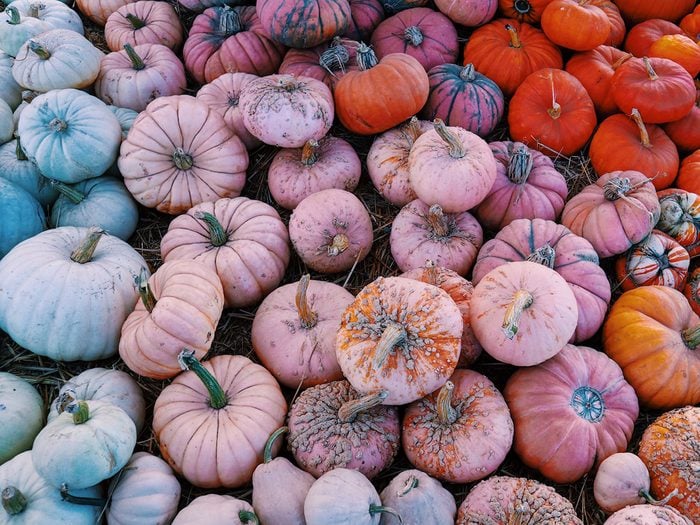Where Are All of These Pink Pumpkins Coming From, Anyway?

The fascinating story behind this Halloween season's most in-demand decor.
Walking through your neighbourhood this fall, you’ll notice a twist on the traditional Halloween hues of orange and black. The classic orange pumpkin has been joined by decorative varieties ranging in colour from pure white to grey, green, blue, yellow, red, and now, even pink.
Here’s what you need to know about those coveted pink pumpkins as well as other gorgeous heirloom varieties that are popping up on porches across the country.
Where do pink pumpkins come from?
While pink pumpkins may be relatively new to consumers in Canada, they’ve actually been around for longer than anyone can date, according to farmer David MacTavish of Burlington, Ontario’s Hutchinson Farm. A common variety of pink pumpkin is the Moranga, a Brazilian gourd that comes in a pale salmon hue.
As decor trends evolve, so does the demand for specific types of pumpkins. Most pumpkins are heirloom varieties that have been bred for decades or even centuries, occasionally with seed companies rebranding or renaming them as a marketing tactic. Occasionally, farmers may cultivate a new hybrid pumpkin such as the Mellow Yellow, an attractive, decor-friendly variety that was introduced in 2019. However, most of the pumpkins you see in Canada today have been grown in Central America for hundreds of years.
“Modern breeding tends to be dominated by orange pumpkins—high-yield pumpkins intended for carving,” MacTavish says. As for why pink pumpkins are suddenly so popular, the answer may be as simple as looking at Pinterest or Instagram. Once the style took off online in the form of social media posts and decorating inspiration boards, demand rose among consumers—in some cases, for a good cause. October is Breast Cancer Awareness Month—an effort that’s often symbolized with pink ribbons—and several nonprofits have started selling pink pumpkins in fundraising and awareness efforts.
Pumpkins are no longer just for Halloween
If you’re looking for some decorative accents to go with those traditional autumnal mums, dried corn husks or hay bales on your front porch, pumpkins are a great option throughout the fall season.
“Thanksgiving is now busier than Halloween in terms of pumpkin demand,” MacTavish explains. “It’s about getting different varieties for decorating versus people just wanting them to carve for Halloween.”
Mixing and matching is a popular decor style. “It’s really nice to decorate your home with contrasting colours and various sizes and shapes, so there’s no one specific cultivar that people are asking for,” MacTavish says. In previous years, all-white pumpkins were on trend and now, pink pumpkins are having their moment along with green and grey pumpkins that lend themselves well to a rustic, earth-toned look.
Are pink pumpkins edible?
Pink pumpkins make great home decor but at the end of the day, they’re still a vegetable in the squash family—so yes, go ahead and cook them up! In fact, according to MacTavish, if a pumpkin is anything other than orange, it’s probably worth a taste. “Orange pumpkins are the worst ones to eat because they’re bred for carving and size.”
That trendy pink Moranga pumpkin from Brazil has a great texture for roasting, and is just the right sweetness for soups and stews. The white Casper pumpkin, reddish-orange Cinderella pumpkin and Red Warty Thing (yes, that’s its name!) are also delicious in savoury dishes.
If you’re baking a pie, you might be tempted to get a Sugar pumpkin because of their popularity in classic fall desserts. These small, readily available gourds are often referred to as “pie pumpkins” due to their sweetness and creamy texture after cooking. While you can definitely go this route, MacTavish asserts that a Winter Luxury pumpkin is far superior in flavour. He also recommends Australian Blue and French Musquee De Provence pumpkins for pie making because of their sweet taste and delicate flesh. (Here are 10 fall pies you’ll want to bake all season long.)
When is a pumpkin ready to eat?
If your front steps are decorated with colourful heirloom pumpkins, keep an eye on the weather. After a few frosty nights, they’ll be ready to enjoy for dinner or dessert. “If you eat pumpkins too early there are a lot of starches, but as they mature, those starches turn into sugar,” MacTavish explains, noting that colder weather helps the process along. “If you wait for those frosty nights, you’ll get great taste.”
Decor you can turn into dinner? Sounds like a great plan to us!
Next, check out 10 tricks for the best Jack-o’-lanterns ever.






